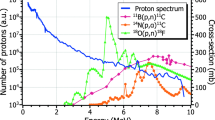Abstract
A novel method of producing fluorine-18 for Positron emission tomography (PET) scan applications is evaluated theoretically. The method is based upon the 3He(d,p)4He nuclear reaction from which the protons produced are used to produce fluorine-18 via the 18O(p,n)18F reaction. The potential advantage of such a system over cyclotron-based production is of lower input beam energy, which may lower the cost of the system and potentially allow for onsite production. Two theoretical designs were investigated. The first utilizes a helium-3 beam incident on a deuterated plastic target such as Mylar which is backed with an oxygen-18 heavy-water (H2O18) target. The second design utilizes a super-heavy-water (D2O18) target effectively combining both targets into one. Theoretical yield calculations were performed for both designs and the practicalities, primarily those of thermal and target degradation effects were assessed. To produce sufficient fluorine-18 yield a 1 MeV helium-3 beam at 100 mA was simulated. For this beam it was calculated that 310 MBq of fluorine-18 activity, as required to scan a 74 kg patient would be generated in a 69 min or an 18 min production run for the Mylar and super-heavy-water systems respectively. The simulated beam is at 100 kW power and without significant cooling would vaporize the target materials with the melting point of Mylar and boiling point of water calculated to be breached within 0.41 μs and 0.45 μs from beam-on. To achieve sufficient fluorine-18 yield the helium-3 beam power had to be increased to impractical levels making the systems technically infeasible.








Similar content being viewed by others
Data availability
Upon publication the authors will consider providing the relevant data and materials upon email request to the corresponding author.
References
Ruhlman J, Oehr P, Biersack H (eds) (1999) PET in oncology. Basics and clinical applications. Springer-Verlag, Berlin
Nuclear medicine diagnostic reference levels (DRLs). Australian radiation protection and nuclear safety agency (ARPANSA) (2017) https://www.arpansa.gov.au/research-and-expertise/surveys/national-diagnostic-reference-level-service/current-australian-drls/nm. Accessed 8 July 2021.
Guillaume M, Luxen A, Nebeling B, Argentini M, Clark JC, Pike VW (1991) Recommendations for fluorine-18 production. Appl Radiat Isot 42(8):749–762
Casella V, Ido T, Wolf AP, Fowler JS, MacGregor R, Ruth TJ (1980) Anhydrous F-18 labeled elemental fluorine for radiopharmaceutical preparation. J Nucl Med 21:750
Blessing G, Coenen HH, Franken K, Qaim SM (1986) Production of [18F]F2, H18F and 18Faq using the Ne20(d, α)F18 process. Appl Radiat Isot 37:1135
Tilbury RS, Dahl JR, Mamacos JP, Laughlin JS (1970) Fluorine-18 production for medical use by helium-3 bombardment of water. Int J Appl Radiat Isot 21:277–281
Bishop A, Satyamurthy N, Bida G, Phelps M, Barrio JR (1996) Production of [18F]F2 using the 16O(3He, p)18F reaction. Nucl Med Biol 23:385–389
Robinson GD, Hamm RW (1997) Fluorine-18 production via the O18(p, n)F18 reaction using the AccSys PL-7 RF proton Linac. AccSys Technology Technical Publication Series, Pleasanton, California, USA
Fritzler S, Malka V, Grillon G et al (2003) Proton beams generated with high-intensity lasers: applications to medical isotope production. Appl Phys Lett 83(15):3030–3041
Ledingham KWD, McKenna P, McCanny T, Shimizu S, Yang JM, Robson L, Zweit J, Gillies JM, Bailey J, Chimon GN, Clarke RJ, Neely D, Norreys PA, Collier JL, Singhal RP, Wei MS, Mangles SPD, Nilson P, Krushelnick K, Zepf M (2004) High power laser production of short-lived isotope for positron emission tomography. J Phys D Appl Phys 37:2341–2345
Ramirez FM, Bulbulian S, Collins CH, Collins KE (1992) A simplified procedure for fluorine-18 production using a nuclear reactor. Appl Radiat Isot 43(11):1403–1406
Geist WH, Brune CR, Karwowski EJ, Ludwig EJ, Veal KD, Hale GM (1999) The 3He(d, p)4He reaction at low energies. Phys Rev C. https://doi.org/10.1103/PhysRevC.60.054003
Takac S, Tarkanyi F, Hermanne A, de Corcuera P (2003) Validation and upgrading of the recommended cross section data of charged particle reactions used for production of PET radioisotopes. Nucl Instrum Meth B 211:169–189
Franks J (1984) Atom beam source. Vacuum 34(1–2):259–261
Keller R (1989) High-current ion sources for ion implantation. Nucl Instrum Meth B 40:518–521
Ziegler JF (2004) SRIM-2003. Nucl Instrum Meth B 219–220:1027–1036
Moller W, Besenbacher F (1980) A note on the 3He + D nuclear-reaction cross section. Nucl Instrum Meth 168:111–114
Shrinet V, Chaturvedi UK, Nigam AKA (1986) Study of blistering in Mylar due to H+ ion implantation. Nucl Instrum Meth Phys Res B 17(1):46–51
Hnatowicz V, Perina V, Havranek V et al (2000) Degradation of polyimide and polyethyleneteraphtalate irradiated with 150 and 200 keV Ar+ ions, studied by RBS and ERD techniques. Nucl Instrum Meth Phys Res B 161–163:1099–1103
Zalm P (1989) Handbook of ion beam processing technology. In: Cuomo JJ, Rossnagel S M, Kaufman HR (eds) Noyes Publications, USA
Rovner LH, Chen KY (1976) MeV He+ bombardment of silicon carbide and carbon. J Nucl Mater 63:307–312
Funding
No funding was received for conducting this study.
Author information
Authors and Affiliations
Corresponding author
Ethics declarations
Ethical standards
No human nor animal subjects were involved in this study and the authors disclose that there are no conflicts of interest.
Author contributions statement
Michael Barnes developed and performed the calculations and wrote the manuscript. Daryl John O'Connor and Martin Ebert developed the original idea and provided scientific expertise in the fields of ion beam physics and Medical physics respectively and also revision of the manuscript.
Conflict of interest
The authors have no conflicts of interest to declare that are relevant to the content of this article.
Additional information
Publisher's Note
Springer Nature remains neutral with regard to jurisdictional claims in published maps and institutional affiliations.
Supplementary Information
Below is the link to the electronic supplementary material.
Rights and permissions
About this article
Cite this article
Barnes, M., O’Connor, D.J. & Ebert, M. Theoretical evaluation of a novel method for producing fluorine-18 for Positron-emission-tomography (PET) applications utilizing the 3He(d,p)4He reaction. Phys Eng Sci Med 44, 843–853 (2021). https://doi.org/10.1007/s13246-021-01037-8
Received:
Accepted:
Published:
Issue Date:
DOI: https://doi.org/10.1007/s13246-021-01037-8




